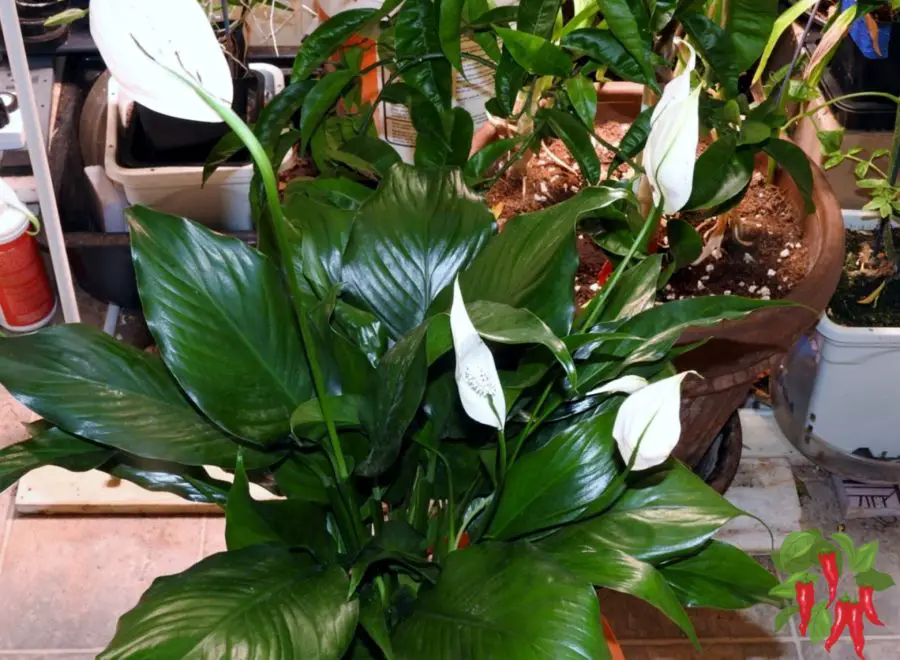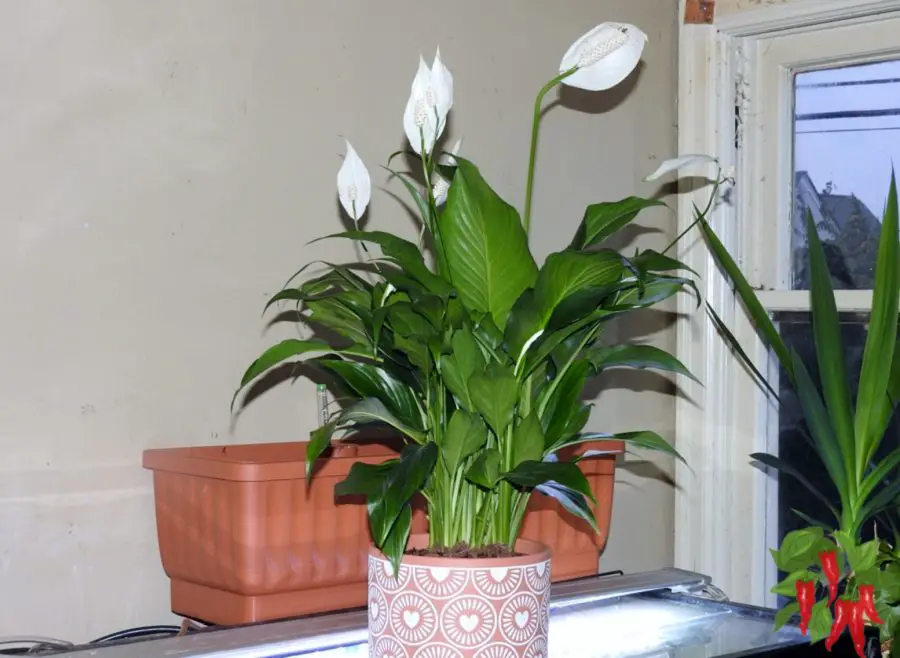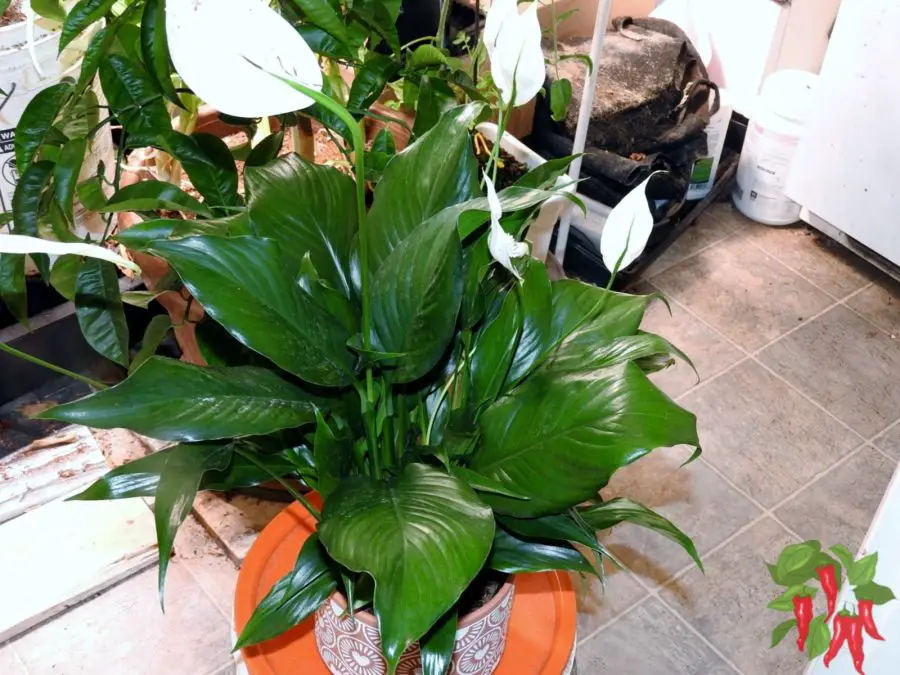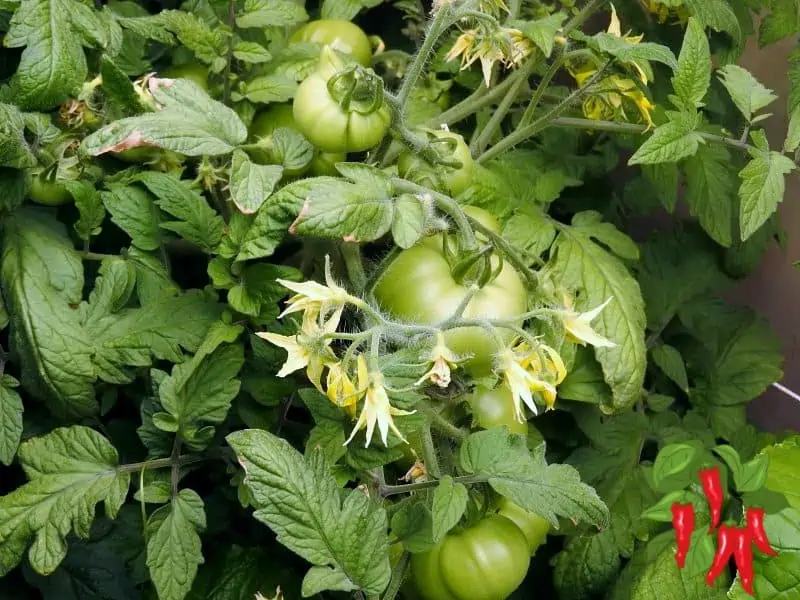This post may contain affiliate links. If you buy something from one of our links we may earn a commission. Thanks

How to care for a peace lily indoors might seem like a mystery when you first bring one home.
These stunning tropical beauties often leave plant parents wondering if they’re giving too much water, not enough light, or why those signature white flowers aren’t blooming.
Here’s the good news – your peace lily will literally tell you exactly what it needs, making it one of the most rewarding plants you can grow!
 Costa Farms Peace Lily, Live Indoor Plant with Flowers, Easy to Grow Houseplant in Decorative Pot, Potting Soil, Thinking of You, Get Well Soon Gift, Room Decor, 1 Foot Tall
Costa Farms Peace Lily, Live Indoor Plant with Flowers, Easy to Grow Houseplant in Decorative Pot, Potting Soil, Thinking of You, Get Well Soon Gift, Room Decor, 1 Foot Tall
How To Care for a Peace Lily Key Takeaways
- Place in bright indirect light.
- Water when the top inch of soil feels dry.
- Maintain humidity above 50% using a pebble tray or humidifier.
- Feed with balanced fertilizer every 6-8 weeks during growing season.
- Keep temperatures between 65-80°F.
- Watch for drooping leaves – they’ll tell you when they’re thirsty!
Caring for Peace Lilies Indoors
Ever walked into someone’s home and spotted those gorgeous, dark green plants with striking white flowers?
Those are peace lilies, and they’re some of the friendliest houseplants you’ll ever meet!
Not only do they look amazing, but they’re also great at cleaning the air in your home.
Whether you’re just starting your indoor plant journey or you’re a seasoned pro, peace lilies are wonderful companions that will let you know exactly what they need.
Let’s dive into everything you need to know about keeping these beautiful plants happy and healthy.
1: How to Care for a Peace Lily Indoors

Think of peace lilies as the “just right” plant – they’re not too demanding, but they’ll definitely let you know when something’s not quite right.
Getting the basics down is your first step to success, and once you understand what makes these plants tick, you’ll find they’re surprisingly easy to care for.
Light Requirements
Just like we don’t like getting sunburned at the beach, peace lilies prefer to stay out of direct sunlight. They’re used to growing under larger trees in tropical forests, so they love bright but filtered light.
• Find the sweet spot – Think of it like sitting in the shade on a sunny day. Your peace lily needs enough light to read a book by, but not so much that it feels like a spotlight
• East-facing windows are your best friend – Morning sun is gentle and perfect for your plant. Put it a few feet back from the window and it’ll be living its best life
• Use sheer curtains as sunscreen – If you only have bright windows, a sheer curtain acts like sunglasses for your plant
• Watch for signs of too much light – Yellowing leaves or brown patches mean your plant is getting sunburned
• Play with placement – Move your plant around until you find where it seems happiest
Watering Needs
Peace lilies are the drama queens of the plant world when it comes to water – and that’s actually a good thing!
They’ll tell you exactly when they need a drink by drooping their leaves, but don’t make them beg too often.
• Check the soil weekly – Stick your finger about an inch deep; if it’s dry, it’s time to water
• Use room temperature water – Cold water can shock the roots (imagine taking an ice-cold shower!)
• Don’t let them sit in water – Empty that saucer after watering, as wet feet lead to root rot
• Look for the droop – A slight droop means “I’m thirsty!” but don’t make this your regular signal
• Consider your environment – You’ll water more in summer and less in winter
2: Peace Lily Care for Beginners

Just starting out? You’ve picked a great plant to begin your journey! Peace lilies are like having a plant with an instruction manual – they’re super clear about their needs and pretty forgiving of beginner mistakes.
Why Peace Lilies Are Beginner-Friendly
• They’re great communicators – The leaves droop when thirsty and perk up when happy
• They adapt well – From bright bathrooms to office corners, they’re pretty flexible
• Bounce back easily – Made a mistake? They usually recover quickly with proper care
• Show clear signs – Yellow leaves? Too much water. Brown tips? Needs more humidity
• Grow at a manageable pace – They won’t suddenly take over your space
Basic Mistakes to Avoid
We all make mistakes, but knowing these common pitfalls can save you (and your plant) some stress:
• Don’t drown them – More indoor plants die from overwatering than underwatering
• Skip the sunbathing – Direct sun will scorch those beautiful leaves
• Easy on the plant food – Too much fertilizer is worse than none at all
• Don’t ignore the humidity – Dry air leads to brown tips and sad leaves
• Hold off on repotting – Wait until your plant is clearly outgrowing its home
3: How to Care for a Peace Lily in the Winter
Just like we bundle up and change our routines in winter, peace lilies need some seasonal adjustments too. Think of winter care as putting your plant in cozy mode!
Winter Light Adjustments
As days get shorter, your peace lily needs a little extra help getting enough light.
• Move closer to windows – Plants can handle brighter winter light
• Keep leaves dust-free – Clean leaves capture more of that precious winter sunshine
• Rotate regularly – Help all sides get equal light exposure
• Watch for drafty windows – Close to the light but away from the cold
• Consider grow lights – If your space is especially dark
Watering and Humidity Changes
Winter heating can really dry out your home, and your peace lily will notice!
• Cut back on watering – Plants need less water when they’re not actively growing
• Keep humidity up – Run a humidifier or use pebble trays
• Check soil moisture more carefully – The top layer might be dry while it’s still wet below
• Use room temperature water – Cold water is even more shocking in winter
• Group plants together – They’ll create their own humid microclimate
4: Peace Lily Not Flowering
Missing those classic white blooms? Let’s get your peace lily back to its flowering glory.
Lighting and Fertilizer Tips
• Check your light levels – Too little light means no flowers
• Use the right food – A phosphorus-rich fertilizer encourages blooming
• Be patient – Plants need to be mature to flower well
• Maintain consistent care – Stress can prevent flowering
• Consider the season – Most peace lilies bloom in spring and summer
5: When to Water Peace Lily
The most common question peace lily parents ask! Here’s how to become a watering pro.
Signs It’s Time to Water
Think of your peace lily as having its own sign language for water:
• The slight droop – When leaves start to sag, it’s definitely time
• Soil check – Dry to the first knuckle means water time
• Pot weight – Light pot = thirsty plant
• Leaf color – Bright green means happy, dull green needs attention
• No moisture meter needed – Your finger is the best tool!
6: Peace Lily Disadvantages
Every plant has its quirks – here are the heads-ups you need about peace lily care.
Safety First
While beautiful, peace lilies do have some considerations:
• Keep away from curious pets – They’re toxic if chewed
• Place out of children’s reach – Better safe than sorry
• Consider placement carefully – High shelves or hanging baskets work well
• Know the symptoms – Usually causes mouth irritation if consumed
• Have emergency numbers handy – Just in case!
7: How to Clean the Leaves of a Peace Lily
Clean leaves are happy leaves! Regular cleaning helps your plant thrive and look its best.
Simple Cleaning Steps
• Use lukewarm water – Just like washing your hands
• Support each leaf – They’re stronger than they look but still need gentle care
• Wipe both sides – Dust collects everywhere
• Skip the leaf shine products – Natural is best
• Make it a monthly routine – Just like dusting your furniture
8. Frequently Asked Questions About Peace Lilies
Getting to know your peace lily better? You’re not alone! Peace lily owners often have similar questions as they learn to care for these beautiful plants.
I’ve gathered the most common questions I hear and provided clear, practical answers to help you on your plant care journey.
Whether you’re troubleshooting a problem or just wanting to provide better care, these answers should point you in the right direction.
Q: How do you keep a peace lily alive indoors?
A: The key is balance – provide bright indirect light, water when the top inch of soil feels dry, and maintain decent humidity. Think of it like creating a mini tropical environment in your home. If you can do these three things consistently, your peace lily will thrive.
Q: How often do you water an indoor peace lily?
A: Most peace lilies need watering every 7-10 days, but don’t stick to a strict schedule. Instead, check the soil with your finger – when the top inch feels dry, it’s time to water. During winter, you’ll water less frequently, while in summer you might water more often.
Q: How do I make my peace lily happy?
A: Peace lilies love consistency! Keep them in bright indirect light, maintain humidity around 50% or higher, water when the top soil is dry, and feed with a balanced fertilizer every 6-8 weeks during growing season. Also, keep them away from cold drafts and hot air vents.
Q: Should I cut the brown tips off my peace lily?
A: Yes, you can trim brown tips using clean, sharp scissors. Cut at an angle to match the natural leaf shape. Just make sure to leave a tiny brown edge rather than cutting into the healthy green tissue, which could cause more damage.
Q: What does an overwatered peace lily look like?
A: An overwatered peace lily will have yellowing leaves (usually starting with older leaves), dark brown spots, and might smell musty. The soil will feel consistently wet, and leaves will droop even though the soil is moist. The stems might also feel soft or mushy at the base.
Q: Do peace lilies like coffee grounds?
A: While peace lilies can tolerate occasional coffee grounds, it’s not necessary or recommended as a regular practice. If you want to use them, sprinkle a small amount (no more than a tablespoon) on the soil once a month. Too many coffee grounds can make the soil too acidic.
Q: Can peace lilies grow in low light?
A: Yes, peace lilies can survive in low light, but they won’t thrive or flower much. They’ll grow slower and might become leggy. For best results, provide bright indirect light – they’ll reward you with more growth and flowers.
Q: Why are my peace lily’s leaves turning yellow?
A: Yellow leaves usually indicate overwatering, but could also mean too much direct sunlight or nutrient issues. Check the soil moisture first – if it’s constantly wet, reduce watering and ensure good drainage. If the soil feels right, consider moving to a spot with less direct sun.
Q: How long do peace lilies typically live?
A: With proper care, peace lilies can live for many years, typically 3-5 years or more. Some well-cared-for specimens have been known to thrive for over a decade! They’ll need dividing every few years, which can actually give you new plants.
Q: How can I get my peace lily to produce more flowers?
A: The key to more flowers is providing enough bright, indirect light and using a fertilizer with higher phosphorus during growing season. Keep in mind that peace lilies naturally flower more in spring and summer, and mature plants bloom better than young ones.
How to Care for a Peace Lily Indoors Conclusion
Growing a peace lily is like having a green friend who’s pretty good at communicating what they need. Once you get the hang of their basic care requirements, you’ll find they’re one of the most rewarding houseplants you can grow.
Key Takeaways
• Listen to your plant – It will tell you what it needs
• Keep it simple – Don’t overthink the care routine
• Stay consistent – Regular care leads to a happy plant
• Learn from mistakes – Every plant parent has them
• Enjoy the journey – Watching your peace lily thrive is truly rewarding
Remember, every peace lily is unique, and part of the fun is getting to know your plant’s individual personality. With these tips and a little patience, you’ll be well on your way to becoming a peace lily pro!
Read more: Indoor Apartment Gardening: 15 Point Comprehensive Guide
Visit my Amazon Influencer Page for videos and gardening products Grow Your Own Garden





